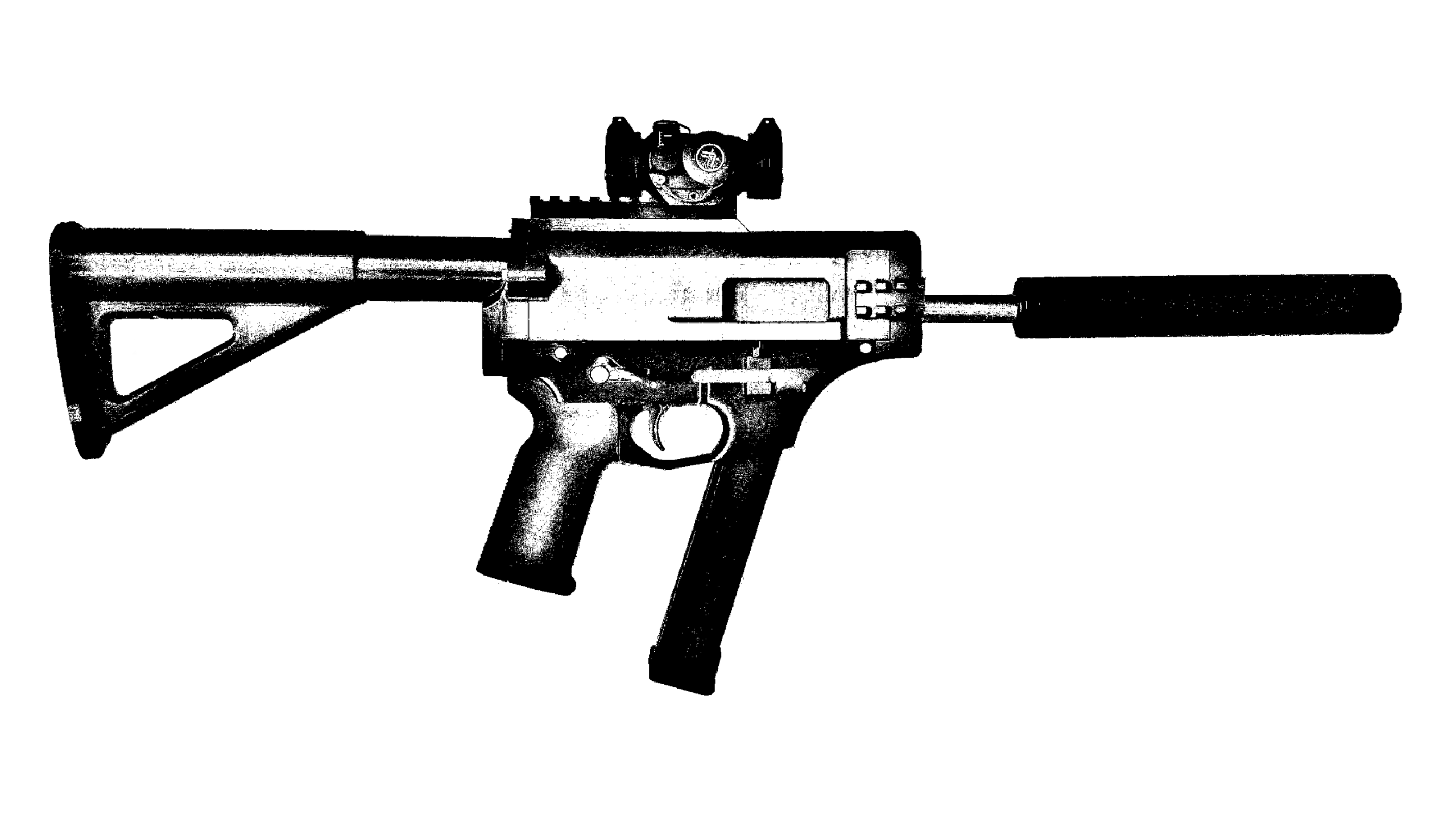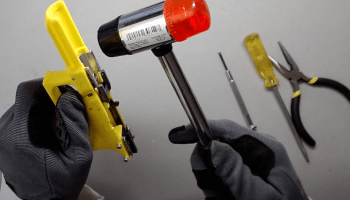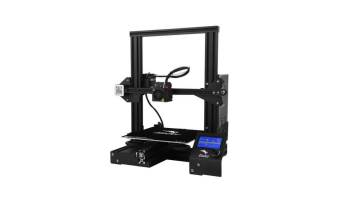The FGC-9 Fulfills the Promise of 3D Printed Guns
The guerrilla 3D-gun file development group Deterrence Dispensed released to the public yesterday the much-anticipated FGC-9 project. The FGC-9 is described in the official release documentation as “the most effective and easiest to build homemade semi-automatic firearm design for people with limited access to gunsmithing knowledge and tools.”
The FGC-9 release is important because it represents a fulfillment of the promise of 3D printed guns: they can’t be stopped. In 2013, the Liberator was proof of concept. In 2020, the FGC-9 is proof of carbine.
The FGC-9 enables everyday people all around the world to build a 9mm semi-automatic firearm, from start to finish, using a 3D printer and commonly available, unregulated materials. It’s specifically designed to be accessible to folks with minimal gun building experience, and avoids using parts commonly or easily restricted by law in the US and Europe. Anyone can build it, and no one can stop it.
In case there was any doubt about the political ideology here, you should know that the ‘FGC’ in the ‘FGC-9’ stands for “fuck gun control”.
Designer JStark1809 details his motivation for the project, “Frustrated by not being able to acquire and bear firearms because of regulations and tyrannical laws, I embarked on the journey to learn to produce my own firearms.”
An anonymous European designer and maker, JStark1809 worked with other prominent developers to complete the project. IvanTheTroll developed the printed Glock magazines and ECM barrel making process, Incarbonite adapted an airsoft M4 fire control group for an AR-15 lower receiver. Others like CtrlPew helped video documentation, and a team of beta testers put the build through its paces before release.
To fully appreciate the importance of this release, one must understand two things:
- What Makes the FGC-9 Special
- How 3D Printed Guns Got to This Point
What Makes the FGC-9 Special?
Thanks largely in part to the efforts of the Deterrence Dispensed group, 3D printed gun developers in recent years have produced a number of functional, high-quality firearms that many nay-sayers thought to be outside the scope of what 3D printed materials could safely produce. Guns like the Glock 17, Tec-9, AK-47, or even Hi-Point, can be anonymously fabricated at home without government oversight using a cheap 3D printer and factory/OEM parts. And they have a serviceable lifespan of thousands of rounds.
But here’s the catch: you still need a factory barrel and parts kit for these guns. The Glock 17 print needs a parts kit and a Glock slide. The Tec-9 needs an upper receiver and parts kit. The AK-47 needs an AMD-65 parts kit. The Hi-Point needs a C9 or C380 parts kit. And these parts kits can be scarce or potentially even regulated by the government.
Currently, most 3D printed guns are really just 3D printed frames, that are later completed using factory parts. Factory parts that can’t practically or easily be made at home.
The above video shows a Tec-9 build at the range. The frame (the purple part) is 3D printed, and the upper (the silver part) is from a factory-produced Tec-9. This is how the majority of current 3D guns are made. There’s no serial number, and no documentation the firearm exists. This is why it’s a ‘ghost gun’. But the construction of the gun is dependent on the availability (and, if you’re a good little boy or girl, the legality) of factory parts in order to come to life as a functional firearm.
The FGC-9 is important because it removes this limitation. The FGC-9 is made almost entirely out of home-built or 3D printed parts and unregulated materials. It can’t be regulated away, and it can be built by anyone. Keep in mind that the main designer is in Europe — where practically no firearms are legal, and items like barrels or frames (which are generally unregulated in the United States) are legally restricted and not readily available in the consumer market — and so the limitations to what could be used in the design process were greater than what’s faced by U.S. based makers.
A Look at the FGC-9
The FGC-9 release file package includes all the knowledge and design files necessary to print and make the gun. It also includes a detailed 110-page build guide, thoughtfully designed to walk the everyday person through the construction and assembly of the firearm.
The FGC-9 is a 9x19mm pistol caliber carbine that is made mostly out of 3D-printed components, utilizes an AR-15 or airsoft M4 rifle fire control group, is compatible with Glock magazines and offers a truly effective, simple to build and reliable tactical option for self-defense and more.
– FGC-9 Documentation
The build files are seeded using the LBRY protocol over a peer-to-peer, distributed network using blockchain. Anyone who downloads the files can share them with anyone else. They can be stored on a USB thumb drive and shared offline or stored. There’s no centralized server or set of mirrors to be taken down via court order. Any efforts to mitigate the propagation of these gun files is purely for show at this point. The signal can’t be stopped.
The FGC-9 documentation offers clear, step-by-step instructions. There are plenty of diagrams, pictures, and schematics. There’s a table of contents. A troubleshooting guide. An email address. There’s an encrypted chat group — almost 7,000 people strong — where people can ask questions and find support. There are guides to 3D printing guns distributed widely across the internet (and even one hosted right here on En Bloc Press).
All told, the FGC-9 release file equips the average person with the tools necessary to produce a quality 9mm semi-auto for less money than most factory-produced 9mm pistol carbines. No government paperwork, no bureaucracy, no permits (after all, free men don’t ask permission). The information is distributed globally and permanently. The only thing required to obtain the gun is the human effort it takes to build it, and access to a printer and common hand tools.
What About the Barrel?
The barrel is a rifled metal barrel, made through a process called electrochemical machining. “Ivan the Troll” developed the easy to replicate ECM rifling process for 9mm barrels, which allows them to be built in small indoor spaces like an apartment or a bathroom. The ECM process lets the average person create a rifled barrel from metal, at home using salt water and electrodes, without requiring expensive machine tools or metal working experience.
Which Magazines Does It Take?
The FGC-9 runs on Glock 9mm magazines. These are readily available in most markets. For people who live in non-free states and countries, the magazines can be 3D printed and produced at home using the ‘Menendez Mag’ (named in honor of Bob Menendez, the anti-gun Senator from New Jersey). These magazines were also developed by Ivan, and the design files for the Menendez Mag are available from Deterrence Dispensed or from the DEFCAD repository.
How 3d Printed Guns Got to This Point
Standing on the Shoulders of Giants
The release of the FGC-9 is especially significant because it represents a complete technological iteration of Cody Wilson’s Liberator pistol. If the Liberator is the first fish squirming out of the sea and onto dry land, the FGC-9 is the first human to stand upright.
The Liberator is a 3D printed, single shot handgun. It rocked the firearm and political world in 2013, when Wilson, and his company Defense Distributed, made the design files available to anyone with an internet connection. The pistol was essentially a minimum viable product, and was entirely impractical to use for self-defense or any other traditional application. But it drew plenty of attention, and it picked a Texas sized fight with the powers that be.

Liberator demonstrated to anyone with a gavel or a voting bloc that guns could be made at home, out of untraceable materials, by regular people. They weren’t practical yet — but it was obvious that eventually they would would be.
The response to Liberator by the government was sudden and severe. The files were ordered to be taken down from the internet. Wilson and his company have been involved in some legal battle or another almost perpetually since the release of the Liberator. The fight has involved years of effort, and involvement by the DOJ, State Department, and 21 separate state Attorneys General. But this fight is of Wilson’s design — and he’s winning.
Fighting Within the Constraints of the System
Cody Wilson, a former law student, has made clear that he believes the American legal system offers protections to free speech and the right to keep and bear arms, and that his endeavors are not only legal but specifically protected. Computer code (and thus 3d printing files) are expressive; they’re free speech. The fact that this free speech can be turned into a gun is also protected. His fight is about principal, not necessarily practicality. He wants his efforts to be vindicated by the system. To be expressly permitted. To be beyond legal reproach.
The government obviously has a major interest in controlling the ability of citizens to possess firearms. 3D printing prevents this, and the government at the federal and state level has fought fiercely against it ever since Cody Wilson first fired the Liberator on YouTube.
Wilson has stated that he views his fight against the government as a struggle against “massive forces — anonymous forces — of discipline and control”, and that he sees liberty as “under siege”.
But Defense Distributed’s challenges in court are expensive and time consuming. Their success is never guaranteed, and their future is always threatened by the power of the State. The administrative state can use its powers of bureaucracy to bog down and smother this otherwise legal pursuit of arming the American citizen. And it’s hard to innovate when you’re stuck in court.
The government’s opposition to 3D printed guns has been an effective warning to others who would seek to adopt a similar business model as Defense Distributed. And to this day, Defense Distributed stands practically alone in their niche, and continues to face ongoing litigation.
The government’s unlimited access to money and lawyers is certainly a strong deterrence to others who may consider a pursuit similar to Cody Wilson’s. It’s been made clear that attempting to operate a legally-recognized company which enables citizens to produce unserialized, untraceable firearms will not go unopposed.
But what the government fails to consider is this: it’s not always about the money.
What if the group in question is motivated purely by ideology? Motivated by the genetic memory of the struggle for independence? By a history of rebellion? By a shared distrust of power? By crypto-anarchists and cypherpunks?
In that case, the heavy-handed legal tactics of the government are not effective at all. In fact, they only fuel the fire of an antifragile network of anarchists, autists, weirdos, libertarians, veterans, crypto hodlers, techies, and shooters — all hell-bent on completely eliminating the viability of any form of gun control.
Enter: Deterrence Dispensed
When the government kills a free market, a black market emerges.
And while the government may have heard Cody Wilson say the ‘genie can’t be put back in the bottle’ in 2013, it’s clear they didn’t listen.
As blue state attorneys general were wasting time and money losing to Cody Wilson in the U.S. Federal Court system, an entirely separate group was gaining in size and capability: Deterrence Dispensed.
Win by Refusing to Play
Borne of the government’s suspension of DEFCAD, Deterrence Dispensed took a different approach to releasing 3D gun files to the public than Wilson’s licensed and incorporated Defense Distributed. Rather than go through the struggle of a protracted legal battle with the federal government and various state governments, they’d simply avoid the hassle of being governable entirely.
The government’s aggressive approach in their attack on Cody Wilson’s Defense Distributed unwittingly accelerated the development and production value of the guns produced by the developers at Deterrence Dispensed.
Operating as a decentralized network of mostly anonymous and pseudonymous gun designers, Deterrence Dispensed has built an impressive library of downloadable 3D printed gun files of their own. They’ve pushed out Glocks, AR-15’s, full-auto conversions, Rugers, Smith & Wessons, Tec-9’s, AK-47’s, and more.
By making use of encrypted email systems, virtual private networks, blockchain technology, dark web .onion domains, cryptocurrency, encrypted chat apps, and a plain old fashioned “we don’t care if it’s illegal” approach, Deterrence Dispensed has a distinct advantage over Defense Distributed: they don’t have a name, an address, or a license. The group itself is nowhere and everywhere all at once.
Having been kicked off of most major social media platforms, Deterrence Dispensed is currently at home on Keybase, an encrypted chat and file sharing system. There are almost 7,000 people in the public chat at the time of this writing. The public group is open to anyone who would like to join.
The Promise of 3d Printed Guns Is Fulfilled
The release of the FGC-9 represents a maturation of 3D printed gun technology. It’s not a novelty. It’s no fad. It isn’t even a one-off idea.
The Liberator is a seed that has grown into an oak.
Governments across the world have tried to stop the spread of access to the 3D print files that fuel the evolution and development of these firearms. But the agents of the state that work against the minds of free men cannot keep pace. The slow-moving bureaucracies and out of touch statesmen that helm these systems of control have been entirely outrun and outmaneuvered by the agility and nimbleness of a distributed network of freedom-minded garage-tinkerers and cypherpunks.
JStark1809’s FGC-9 release is proof that “undisciplined freemen are superior to veteran slaves”.
Notes:
- For a deep-dive of the state of 3D printed firearms, read the ARES Research Report on Desktop Firearms, with contributions by Ivan the Troll.
- Deterrence Dispensed’s public chat can be found here
- Get started with 3D printing guns here









